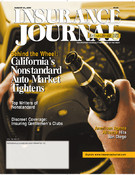Fremont General Corporation, the nationwide insurance and financial services holding company, posted a combined ratio for second quarter 2000 of 259.0 percent, compared to 95.7 percent reported for second quarter 1999.
Also posted in the Company’s most recent Quarterly Report (SEC form 10-Q), released Aug. 14, was a net loss of $268,073,000, or a $4.26 diluted net loss per share, for the three months ended June 30, 2000. For the same period in 1999, the company reported net income of $34,975,000, or 50 cents diluted earnings per share.
The Company’s second quarter 2000 net loss is the result of a $270,318,000 net loss from continuing operations combined with an extraordinary gain after taxes of $2,245,000.
The Company’s property and casualty insurance segment posted a loss before taxes for both the three and six months ended June 30, 2000 of $425.8 million, compared to income before taxes of $42.2 million and $84.5 million for the same respective periods one year ago. The report cited the major cause for the loss before taxes in 2000 as a $450-million increase in the Company’s gross liability for loss and loss adjustment expenses under workers’ compensation insurance policies effective in or prior to 1999.
It was also reported that $336 million and $635 million in revenues were generated in the three and six months ended June 30, 1999, respectively. For the same respective periods ended June 30, 2000, revenues totaled $428 million and $821 million, increases which were attributed primarily to an increase in workers’ comp premiums in the p/c segment as well as higher loan interest in the financial services segment.
Premiums from the Company’s p/c operations were $289.6 million and $548.7 million in the three and six month periods ended June 30, 2000, compared to $197.6 million and $368.0 million in the respective periods one year previously.
The Company’s in-force premiums at June 30, 2000, were $974.6 million compared to $942.8 million at June 30, 1999.
The release of the report came just a few days after an A.M. Best rating action in which the financial strength rating on the Company’s workers’ compensation insurance subsidiaries, the seven members of Fremont Compensation Insurance Group (Fremont), were downgraded from “B++” (Very Good) to “B” (Fair). The financial strength rating on the subsidiaries was previously downgraded, from “A-” (Excellent), on March 1, 2000.
Michelle Baurkot, senior financial analyst for A.M. Best, discussed some of the factors which contributed to the most recent downgrade, which she said reflects Best’s ongoing concerns about Fremont’s weakening balance sheet as well as the growing evidence of further material reserve shortfalls in the California workers’ comp market.
“When we had downgraded Fremont in March 2000, it primarily reflected significant reserve strengthening,” Baurkot explained. “At that point, we cited that we still had ongoing concerns with the reserve position.
“With what’s happening in the market and just what was going on with the company, we felt that we needed to downgrade them again to ‘Vulnerable’ [from ‘Secure’] because of the implications it could have on the balance sheet and also future operating performance should they need to take a reserve-strengthening action.”
Baurkot said that at this point, A.M. Best would continue to monitor the situation, and that the ratings would probably remain under review with developing implications.
With regard to the holding company’s quarterly report, it was announced that the Company had entered into a letter of intent with XL Capital Ltd., which in part establishes an adverse development reinsurance agreement between one of XL’s insurance subsidiaries and the Company’s workers’ comp subsidiaries. In addition to covering the Company’s workers’ comp losses, primarily those from 1999 and prior years, the agreement is expected to offset the impact of losses in the second quarter of 2000 on the Company’s p/c insurance operation.
A spokesman from Fremont General Corporation would not comment on the quarterly report.
Was this article valuable?
Here are more articles you may enjoy.


 Supreme Court Rejects Challenge to $2.46B Boy Scouts Sex Abuse Settlement
Supreme Court Rejects Challenge to $2.46B Boy Scouts Sex Abuse Settlement  Billionaire NFL Owner Suing Over Billboards Near His LA Stadium
Billionaire NFL Owner Suing Over Billboards Near His LA Stadium  SIAA Announces Strategic Partnership With Progressive
SIAA Announces Strategic Partnership With Progressive  Consumer Acceptance of Telematics Widens, Says Survey
Consumer Acceptance of Telematics Widens, Says Survey 


